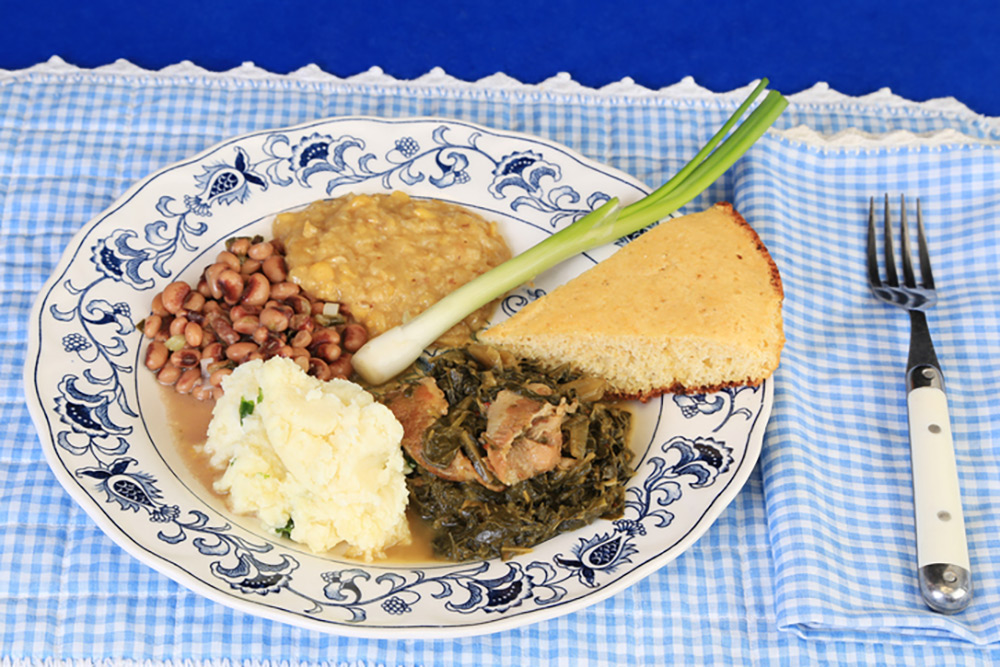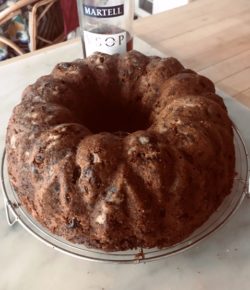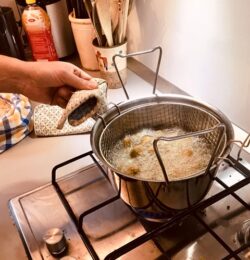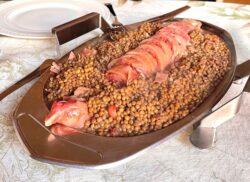
Starting the New Year Southern-style with ham, greens, black-eyed peas, and cornbread at center stage. / Photo here, and on the front, iStock.
After owning one of the best cooking stores in the US for 47 years—La Cuisine: The Cook’s Resource, in Alexandria, Virginia—Nancy Pollard now writes Kitchen Detail, a blog about food in all its aspects—recipes, film, books, travel, superior sources and food-related issues. She and her husband, the Resident Wine Maniac, have recently moved to Italy.
I DON’T REMEMBER a specific tradition in my family for a New Year’s Day meal. My mother’s family came from Chicago (she spent her childhood in the tough copper-rush town of Butte, Montana). My father’s family were staunch Philadelphians of the Main Line variety. The only thing I remember was my father’s affinity for Pepper Pot Soup and stories of celebratory meals as a child at Bookbinders in central Philadelphia. By the time my husband and I ate there, it had become a dreadful tourist trap, then mercifully closed under a cloud of bankruptcy proceedings.
Breakfasts from Christmas through New Year’s always included stollen, a tradition that carried over from our years of living in post-war Germany, but there was no set tradition for either a Christmas or New Year’s meal. In contrast, in my husband’s family, who hailed from Mississippi, the New Year’s Day meal was ironclad: You had a ham, black-eyed peas and greens, and cornbread. For dessert, it was always his mother’s version of ambrosia (fresh orange slices with shredded coconut) and her absolutely divine fruitcake.
I recently learned that having a ham is linked to future prosperity. Some theorize that it’s because hogs always move forward while foraging for food, unlike cows, who stand still while munching, and the poor benighted chickens, who move backward. Thus, ham became a symbol to look forward to a good year. Black-eyed peas were absolutely necessary if there were to be any good luck in the new year. Cornbread represented gold, and collard or kale greens represented greenbacks or dollars. That the black-eyed peas came with a West African heritage serves as a poignant reminder to me of America’s fraught history. My mother-in-law always made a chocolate soufflé for New Year’s Eve, but that was her own tradition, which we are happy to honor every New Year’s Eve as well. Her recipe came from The Joy Of Cooking. I switch from year to year with either Simca’s Flat Soufflé or the one from Christian Felder.
On the Shoulders of Giants
My only contribution to creating a family tradition has been crushing candy canes from our Christmas tree and making Peppermint Ice Cream for New Year’s Eve (with hot fudge sauce, naturally). So it was with great interest that I participated in an Italian New Year’s Day dinner this year. I was warned by my son-in-law that there was going to be no experimentation allowed (my reputation preceded me), that their New Year’s Day dinner rested on the shoulders of giants, a phrase he borrowed from Sir Isaac Newton. Certain foods were symbols for welcoming the new year and one best not tamper with them.
A platter of thinly sliced salami, culatello (it really is better than prosciutto) with cheeses is served with an aperitivo. If you are from the Marche region, east of Tuscany, the famed olive ascolane will be included. This is a breaded, and deep-fried olive filled with a delicious meat stuffing where the pit once was. It’s a tradition I could get used to.
This is followed, at least in this house, with Zampone. Other Italian homes may choose Cotechino instead, but both represent prosperity. According to ArteCibo: “Traditionally, zampone is the lower leg, or ‘trotter’ of the pig with the central bone removed, while cotechino is made from filling the intestines. The meat and rind stuffed into leg and intestine alike is the same: cheek, shoulder, neck and head; along with various fragrant spices.”
You can buy Zampone or Cotechino already cooked and prepared or you can buy the “artisanal” variety and gently simmer the piece through the night of New Year’s Eve. One year I was given the duty of waking up occasionally during the wee hours to make sure that there was enough water to keep the artisanal version gently poaching. I have become particularly fond of the hoof end of Zampone, as it has some of the same chewiness that I love in tripe. This is accompanied by the particular lentil grown in the Sibillini mountain plains, Castelluccio. This golden-brown lentil is as delicious as the LePuy lentils grown in the mountainous plains of the Auvergne in France. This particular lentil symbolizes the prospect of money in the New Year. The Zampone is then served with the lentils and a purée of potatoes (not to be confused with our fluffy mashed potatoes). Dessert is probably one of the many Christmas cakes that are made in various Italian regions. It is filling, hearty, and as good a way to start the new year as ham, black-eyed peas, greens, and cornbread.
One thing I find intriguing is that this Italian tradition for New Year’s Day is so similar to that of the American South. Other Italian New Year’s customs haven’t made the trip south of the Mason-Dixon line. Whew. I simply cannot imagine my mother-in-law, not to mention my husband, hewing to the Italian tradition of throwing old kitchenware and even appliances out the window, or even wearing red underpants. I’m happy it’s the symbolic foods that form the bedrock of a New Year’s Day meal to herald the forthcoming year that are mysteriously aligned.





